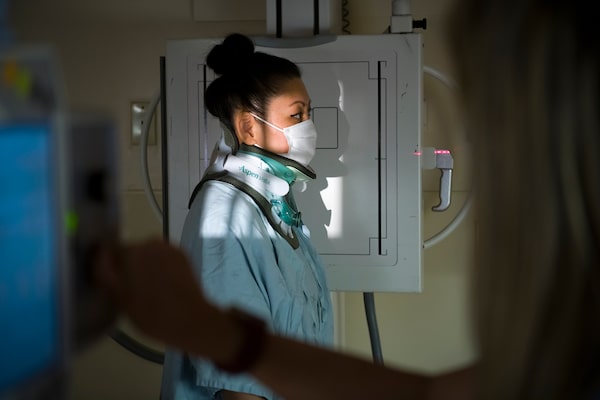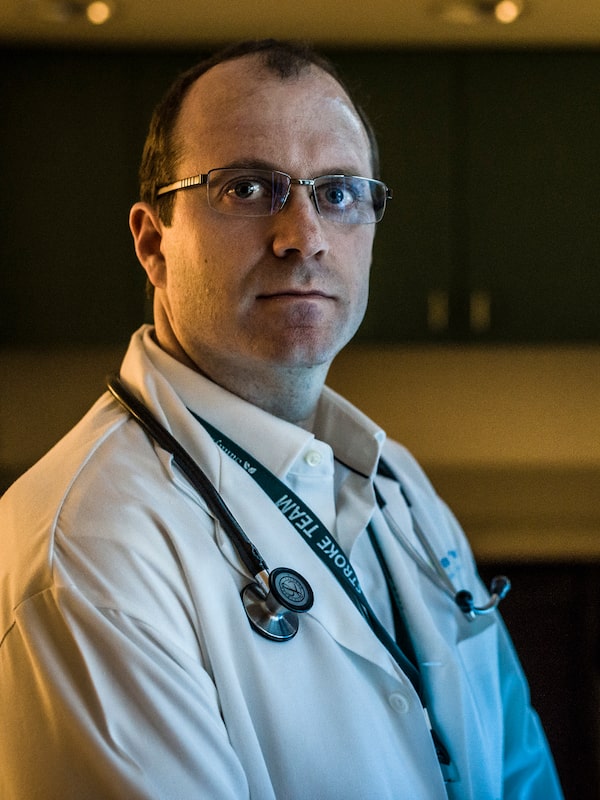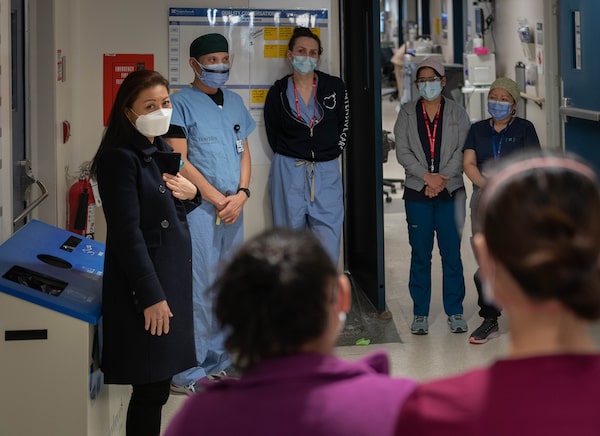
Jenny receives x-rays at Sunnybrook to determine progress of her neck injury recovery for the removal of her brace.Doug Nicholson / Sunnybrook Health Sciences Centre
November 3rd, 2021 may have been both the unluckiest, and luckiest, day in Jenny Shin’s life.
That morning, the Toronto public relations agency owner experienced a sudden, severe stroke. Jenny’s sister, Betty, was driving the two of them to work, and Jenny was using the morning commute to take a call with a client.
“I felt a bit dizzy, and I started seeing rainbow-coloured balls,” recalls Jenny, who was then 47. “[But] I kept trying to push through in the conversation.”
The feeling worsened. As she attempted to wrap up the call, she heard, “Jenny, are you OK?” on the other end. That’s when she suspected she was having a stroke. She tried to alert Betty but could only produce garbled sounds.
“I thought, what’s that sound? Oh my God, that’s me talking,” she says.
The Globe and Mail
While Betty wasn’t sure what was happening, she recognized that the slurred speech and facial drooping signaled a medical emergency and took her to the nearest hospital. Jenny’s condition got even more complicated when she later fell out of the car, tumbling head-first to the ground. Jenny would find out later that in addition to experiencing a life-threatening stroke, she had just broken her neck.
Lying on a stretcher with her neck in a brace, Jenny recalled a conversation with a neurosurgeon friend who told her nearly two million brain cells die every minute a stroke is untreated. “I remember being aware that my brain cells were dying off in droves,” she says.
That’s where luck played a part. While Jenny’s life would hang in the balance for the next several hours, she was about to become a living example of how the research and expertise at Sunnybrook Health Sciences Centre have advanced stroke treatment not just in Canada, but around the world.

Jenny with Dr. Houman Khosravani, medical director of the inpatient stroke unit at Sunnybrook and a clinician specializing in stroke innovation.Kevin Van Paassen/Sunnybrook Health Sciences Centre
Efficiency and care in an urgent situation
Inside the ambulance en route to Sunnybrook, watching the digital clock blink to mark each passing second, Jenny thought she was minutes from dying.
The ambulance arrived at its destination and the hospital doors flung open. A team of medical personnel rushed out.
“It was like [the tv show] Grey’s Anatomy,” remembers Jenny. “It was a well-oiled machine. I was so impressed.”
The team’s superlative efficiency was the result of several years of careful work and planning with a laser focus on quality improvement and patient safety in a joint collaborative effort between the stroke program, the emergency department, diagnostic imaging and neurovascular surgery.
“One of the things that has been very effective in our approach to caring for stroke and getting patients assessed in a timely, safe and efficacious manner has been focusing on the human elements that go into running this urgent situation called a code stroke,” says Dr. Houman Khosravani, medical director of the inpatient stroke unit at Sunnybrook and a clinician in quality and innovation.
Some of the principles of the team’s approach are borrowed from the aviation industry, he explains, including routine simulations and debriefings as well as “closed loop” communication.
“A request is made, and the person who is going to be carrying out that request repeats it back to confirm,” explains Dr. Khosravani. “People outside the room can also hear it using a monitoring system.”
He and his colleagues have further refined their approach, terming the way they respond during an acute brain injury as neurovascular resuscitation. “It’s a term that we have pioneered – resuscitating the brain in the context of stroke,” he says.

Neurologist Dr. Rick Swartz says the broad range of expertise in collaboration at Sunnybrook’s Garry Hurvitz Brain Sciences Centre will offer unique advantages for studying stroke in the future.Doug Nicholson/Sunnybrook Health Sciences Centre
Power of the ‘chain of survival’
Dr. Khosravani notes that Jenny’s case demonstrated “the power of what we call the chain of survival,” meaning that the neurosurgical and neurovascular teams had to work together to balance the complexities of two potentially life-threatening conditions – a significant neck fracture and a stroke.
“We knew we had to take rapid images of the brain first, and then make sure the spinal cord was okay,” he says.
Minutes after imaging revealed the presence of a sizeable clot in one of the larger vessels in Jenny’s brain, she underwent a treatment at Sunnybrook, which was a site in the early clinical trials and has now become a worldwide standard of care for certain patients: endovascular thrombectomy – mechanical retrieval of the clot using a fine tube threaded from a vessel in the groin up into the brain.
That procedure is just one of the ways Sunnybrook is at the leading edge of research and care in stroke. In another example, Sunnybrook researchers recently led a pivotal study with colleagues in Calgary proving that tenecteplase, a clot-busting drug that is much faster and easier to administer, provides outcomes comparable to the previous industry standard.
While the drug normally used to treat clots is delivered via an infusion pump that must be supervised, tenecteplase “is given as just one shot in the arm – boom, done,” explains Dr. Rick Swartz, medical director of the North & East GTA Regional Stroke Program and one of the study co-authors. “And we know that the quicker people get treated, the better their outcomes.”
Published in June 2022, the research has already begun influencing stroke treatment guidelines.
Dr. Swartz is co-leading a trial investigating another medication that can be given in the ambulance. “[That drug] could protect the brain – get it to ‘hold its breath,’ so to speak – while we get the vessel open,” he says.

During a visit to Sunnybrook, Jenny Shin takes a moment to thank the multi-disciplinary team in the Neurovascular Unit.KEVIN VAN PAASSEN / SUNNYBROOK HEALTH SCIENCES CENTRE
A state-of-the-art facility like no other
Dr. Khosravani notes that Sunnybrook is “perfectly situated” to work on innovation in brain sciences because their stroke program “is nestled within a large body of expertise in neurosciences, including cognitive neurology, neuromuscular conditions, sleep medicine, neuromodulation and neurosurgery.”
It’s a philosophy of multidisciplinary collaboration that will be embodied in Sunnybrook’s under-construction Garry Hurvitz Brain Sciences Centre, a state-of-the-art facility that will be unprecedented in the field of brain sciences.
A three-storey facility spanning 121,000 square feet, the Centre will house internationally renowned researchers across multiple disciplines, working to accelerate the discovery of the next generation of treatments for the most devastating brain disorders, including stroke, dementia, Alzheimer’s disease, ALS and mood and anxiety disorders.
Dr. Swartz says that the broad range of expertise at the Garry Hurvitz Brain Sciences Centre will offer unique advantages for studying multiple aspects of stroke, from the role it plays in the development of dementia to how sleep disorders may increase stroke risk.
“With that brain sciences lens, we’re interested in trying to intervene and get positive outcomes at every stage of the stroke journey, from the ambulance in the driveway all the way to ten-year outcomes,” he says.
Philanthropy plays an essential role in pushing the boundaries of research and development in neuroscience at the Garry Hurvitz Brain Sciences Centre, says Dr. Khosravani.
“Philanthropic support is able to provide a major inflow of resources to do advanced, cutting-edge studies,” he says.

Jenny has returned to her life after her harrowing experience, saying that being able to let go of “any worries or fear” at Sunnybrook made all the difference in her recovery.Sean Liliani
As for Jenny Shin, after some time in the ICU, she transitioned to Sunnybrook’s Neurovascular Unit. There, she received multidisciplinary care including physical therapy, which was continued at Sunnybrook’s St. John’s Rehab.
With perseverance and hard work, Jenny eventually graduated to walking in her signature high heels. Now, she’s grateful for the leading-edge care that has allowed her to return to her life.
“From the moment I arrived at Sunnybrook, I knew I was in the care of the best possible talent,” she says, “so I let go of any worries or fear, which made all the difference in my recovery.”
Learn more at sunnybrook.ca/brain
Advertising feature produced by Globe Content Studio with Sunnybrook Health Sciences Centre. The Globe’s editorial department was not involved.